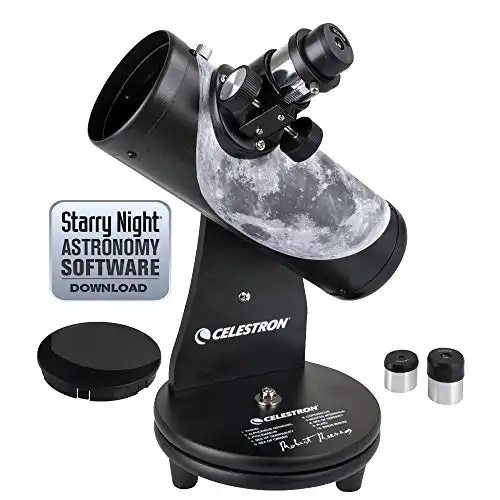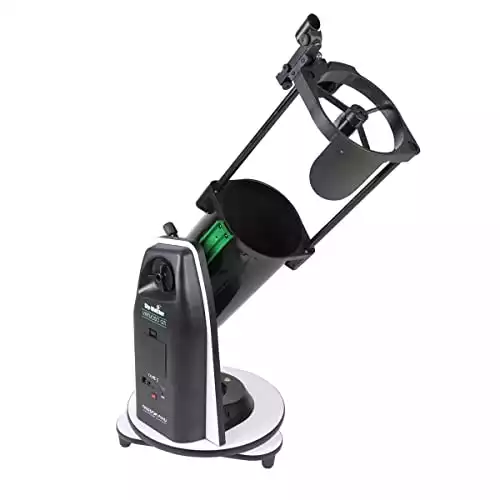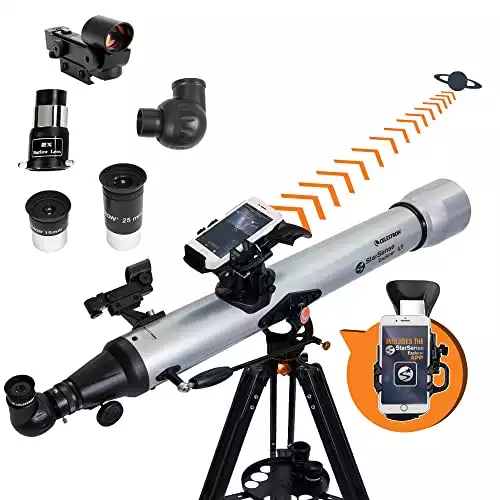A telescope can make a great present for a child. It can:
- Stimulate interest in space and science
- Get them outside and away from screens
- Be something that a family can do together in the backyard or on trips
In this article, we recommend the best telescopes for kids and explain what you should look for.
Here are links to our top picks or read on for more detail on each model.
|
Make & Model: |
Make & Model:
Celestron Travel Scope 70 DX
|
Make & Model:
Sky-Watcher Virtuoso GTI 150P
|
Make & Model:
Celestron StarSense Explorer LT 80AZ
|
|
Aperture:
3-inch (76 mm)
|
Aperture:
2.8-inch (70 mm)
|
Aperture:
6-inch (150 mm)
|
Aperture:
3.1-inch (80 mm)
|
|
Weight:
3.6 lbs (1.6 kg)
|
Weight:
3.3 lbs (1.5 kg)
|
Weight:
19 lbs (8.6 kg)
|
Weight:
9.2 lb (4.2 kg)
|
Best Telescopes for Kids
Celestron FirstScope
Best Budget Telescope for Kids
This is a great little telescope that is intended as a first telescope for beginners and children (hence FirstScope).
It is lightweight, portable, and can be set up without tools.
The 3-inch (76 mm) aperture is enough to provide good views and detail of the moon and of the planets like Saturn and Jupiter if the conditions are right.
It is a tabletop Dobsonian reflector telescope. This means that it doesn’t sit on a tripod like other telescopes, but rather has a built-in stand.
This makes it easy to use and is perfect for a parent and child to use together on a table in the backyard on a nice evening.
You can watch a quick overview video of this telescope from Celestron here:
Pros
- Cheap – great value for the price
- Small and light – easy to pick up and use at any time and easy to store
- Easy to use – simple to get viewing with for all the family
- Capable of smartphone photography with an adapter
Cons
- 3-inch aperture is not ultra-powerful and so don’t have expectations too high about what you will be able to see
- Needs a good backyard table to get the best use from
- Not GOTO/computerized. You’ll have to manually locate what you want to look at.
Overall, this is a great value kids telescope and perfect for a beginner or child to use in the backyard.
Key specifications
- Type: Dobsonian Reflector
- Aperture: 76 mm (3-inch)
- Weight: 3.6 lbs (1.6 kg)
- Mount: Manual Alt-Azimuth
Tabletop Dobsonian-style telescope for kids.
- High quality Dobsonian style stand with a 76 mm reflector optical tube make FirstScope an ideal entry level astronomical telescope
- Portable and lighweight table-top design makes it easy to store, transport and setup your FirstScope Telescope
- FirstScope is very easy to observe with, the user simply navigates the night sky by moving the tube in the direction of their desired object
Celestron Travel Scope 70 DX
Most Portable & Easy to Store
Our next recommendation is the Celestron Travel Scope 70 DX.
This is designed as a travel telescope but we think that much of what makes it good for travel, also makes it good for children and families:
- It weighs just 3.3 lbs and no tools are required to quickly and easily get it set up.
- It comes with a backpack included with space for all the accessories including the tripod. This is an underestimated positive as many families (like mine) value being able to pack their telescope away nicely and declutter.
- It comes as a package with everything you need in one, including the backpack, tripod, and even a smartphone adapter and BlueTooth remote for photography.
Here is a video overview from Celestron of this telescope:
The main downside of this telescope is the fairly low power in a 70mm / 2.8-inch aperture.
If you have a bit more budget then there is a more powerful Celestron Travel Scope 80 that gives you a higher 80mm aperture and therefore better viewing capacity.
There are also 50mm and 60mm versions of this telescope, but these have even more reduced power and so we wouldn’t recommend them.
Overall, this is a great option if you value having something that can pack up and store easily, and then be grabbed for a trip or set up quickly in the backyard for some fun.
Key specifications
- Type: Refractor
- Aperture: 70 mm (2.8-inch)
- Weight: 3.3 lb (1.5 kg)
- Mount: Manual Alt-Azimuth
Portable Refractor Telescope
- The Celestron 70mm Travel Scope features high-quality, fully-coated glass optics, a potent 70mm objective lens, a lightweight frame, and a custom backpack to carry it all.
- Equipped with 2 high-quality eyepieces (20mm and 10mm) plus bag, tripod, moon filter, 2x barlow, bluetooth shutter release, smartphone adapter and software.
- Perfect for families to use in the backyard or take on trips.
- Aperture not huge
Sky-Watcher Virtuoso GTI 150P
Upgrade Pick
Our upgrade pick over the Firstscope above is this Sky-Watcher Virtuoso GTI 150P:
- It is another tabletop Dobsonian telescope. Meaning that it is easy to use in the backyard and doesn’t require attaching to a tripod.
- It has a much-increased power capacity at 6 inches (150 mm), meaning that the views you can expect will be much better.
- It has a GOTO / computerized base which is controlled by smartphone app. This means that it scans the night sky and moves to what you want to look at at the press of a button.
Therefore it is a better and more advanced telescope. It would be suited to an older child or for a younger child with the help of a parent.
The GOTO functionality takes the astronomy experience to another level as you no longer have to manually locate astronomical objects using manual star maps or similar tools.
You can just look at what is available to view from a list on the app, select something, and it will take you to it.
You can watch an overview of this telescope in this video:
The downsides of this telescope are:
- Inevitably the higher power and GOTO base means it costs more
- It is fairly heavy at 18 lbs
Overall, this a great option if you like the tabletop telescope style but want more power and the GOTO functionality.
Key specifications
- Type: Dobsonian Reflector
- Aperture: 150 mm (6-inch)
- Weight: 18 lbs (8.6 kg)
- Mount: GOTO Computerized
Collapsible Tabletop GoTo Dobsonian Telescope
- 6-inch aperture for great views
- Fully GOTO Computerized base
- Convenient collapsible tabletop design
Celestron StarSense Explorer LT 80AZ
Best for Older Kids
Our final recommendation is the Celestron StarSense Explorer LT 80AZ.
This is a great telescope for teenagers or for adults to use with younger children as it interacts with your smartphone to make it easy to find things in the night sky.
Celestron’s StarSense app allows you to connect your smartphone to the telescope. Then, using the app provided, it scans the night sky above you and tells you what you can see that night and guide you to it.
For example, if Jupiter or Mars are above you that night, you can select them on the app and then follow the arrows on the app to point the telescope at them.
This is a really great feature that makes the whole process easier and more enjoyable.
Here is a quick video that shows this:
This makes it significantly easier to find things in the night sky, which can be a major frustration for astronomy beginners.
It also gives you something close to what you’d get with a computerized telescope, it just won’t move the telescope for you. An advantage is that it is cheaper and doesn’t require a power source in comparison to computerized telescopes.
This model has 80mm (3.1 inch) aperture, which is enough for great sights.
There are also other, larger StarSense Explorer telescopes. If you think you might prefer one of the more powerful models then see our article here that explains the options.
Essentially though, the higher aperture options are either heavier and bulkier, or more expensive, and so we think this model is a great option for kids or teenagers.
- Innovative smartphone interactivity takes advantage of the technology you have in your phone to make it much easier to find things in the night sky
- Relatively small and compact
- Capable of smartphone photography with an adapter
- Much cheaper than a computerized telescope but with similar advantages from the StarSense technology. Also requires no power source
- A bit heavier and more setup work is required in comparison to a tabletop telescope
- Not that powerful at 3-inch aperture (although just about ok)
- Type: Refractor
- Aperture: 80 mm (3.1-inch)
- Weight: 9.2 lb (4.2 kg)
- Mount: Alt-Azimuth
Smartphone App-Enabled Telescope
- Let your iPhone or Android phone take you on a guided tour of the night sky.
- The app tells you what’s in the sky based on your exact time & location. Follow the on-screen arrows to your desired target. When the bullseye turns green, it’s ready to view in the telescope’s eyepiece.
- View planets, brighter nebulae, galaxies, and more.
- Too bulky for easy travel
How to Choose a Kids’ Telescope
Buying a telescope can be pretty bewildering. There are hundreds of different models with all sorts of different specifications, shapes, and sizes.
To help with this, we believe that you can narrow it down to three different things to consider:
- Aperture – this is the best measure of power and how good it will be to look through (the higher the better)
- Size, weight and ease of use – the practical aspects are more important than you might think to make sure you get a telescope that will actually be used
- Cost – You can spend anything from $50 to $5000 on a telescope, so set your budget and work out what’s best for you within that price range
Let’s examine these three aspects in more detail.

Aperture
The aperture of the telescope is the key specification when it comes to how good a telescope will be for looking at the night sky.
You can ignore things like magnification, focal length, and focal ratio as they won’t mean much for this level of telescope. It’s all about aperture – the higher this is, the better you will be able to see through it.
This number is usually clearly stated in the name of the telescope – e.g. Celestron Travel Scope 80 = 80 mm aperture.
We would recommend an aperture of at least 2.8 inches (70 mm). Below this and you might be disappointed with what you can see.
The higher the better, but the cost tends to go up as the aperture goes up (although other factors can also increase the price).
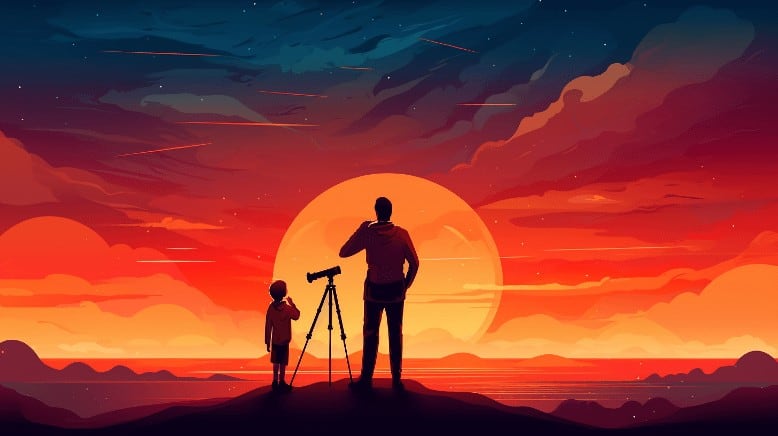
Size and Weight
This is where you need to think about the age and capacity of the child who will be using it, where they will be using it, and where you will store it when not set up.
Some telescopes marketed to children are very heavy and bulky. This might be ok for a teenager in a house with plenty of space, but this won’t be for everyone.
With regards to the size, think about whether you have a good space at home for it to be set up all the time or whether it will need to be packed away.
If it will be packed away, it’s worth considering if it comes with a bag or case so that it fits together properly. Telescopes, tripods and accessories are often awkward shapes for storing.
For the weight, think about whether you be the child will be using it on their own or with an adult helping:
- If it will always be with adult supervision then perhaps you can get something heavier as you will be the one setting it up and operating it.
- If it’s for a child or teenager to use on their own, perhaps it needs to be a bit lighter so they don’t drop it and hurt themselves and/or break it.
Most people will value telescopes being smaller and lighter, but you have to balance this with its capacity to provide good views as defined by its aperture. As aperture goes up, you see better sights but the telescope tends to get bigger and heavier.
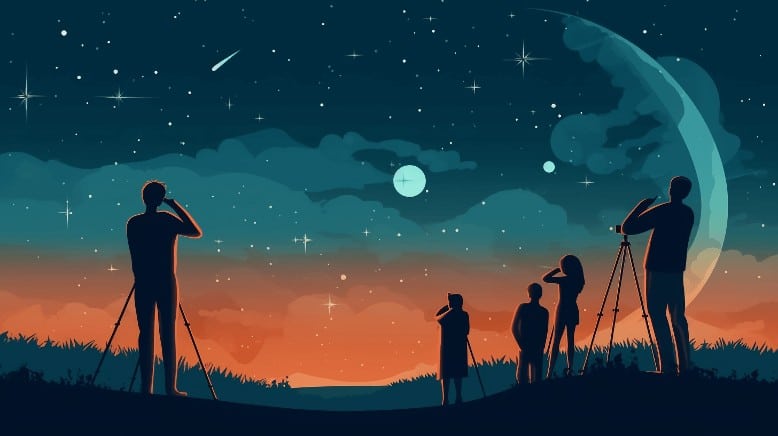
Ease of Use
This relates to the above points as telescopes can be frustrating if you can’t get them set up easily and start seeing some sights through them quickly.
For children especially, you want a telescope that is simple to set up and operate so that their enthusiasm grows and they want to learn about what they are seeing.
If the telescope is too advanced for their age and capacity they will likely just give up on it. (Note, as an adult I did this with my first telescope!)
Much of this will relate to the type of telescope and there are three main types with key differences:
- Refractors are the easiest to use and the most ‘traditional’ telescopes in terms of appearance
- Reflectors provide the best value in terms of power (aperture) to price but tend to be bigger, bulkier, and heavier (apart from the tabletop models that we recommend above)
- Catadioptrics tend to be compact and light but are the most expensive

The Mount
The other thing to consider that relates to the above is the telescope mount.
This will come included when buying a telescope package along with the telescope tube and tripod. It is the part that sits between these things and is what you use to operate and point your telescope.
There are two main types of mount:
- Alt-Azimuth (including Dobsonian) – this is the easiest to use and best for observing/astronomy
- Equatorial – these are best for advanced astrophotography and are much more cumbersome and harder to use
You will almost certainly want an alt-azimuth mount for a child as it’s much simpler – you just point and look.
When shopping, many people are tempted to buy reflector telescopes with equatorial mounts (like a Celestron PowerSeeker) because they seem to provide good value for money in terms of power (aperture).
However, the reality is that these are very cumbersome and hard to operate and lead to a lot of people giving up.
In my opinion, for kids, you need to favor something that will encourage their interest and not squash it because it doesn’t seem rewarding at the start.
You can also get telescopes that come with computerized (or “GOTO”) mounts. These find objects in the night sky above you at the press of a button (usually from a hand controller or, more increasingly, a smartphone app).
These are great but more expensive, more complicated, and also require a power source, which can make them less portable.
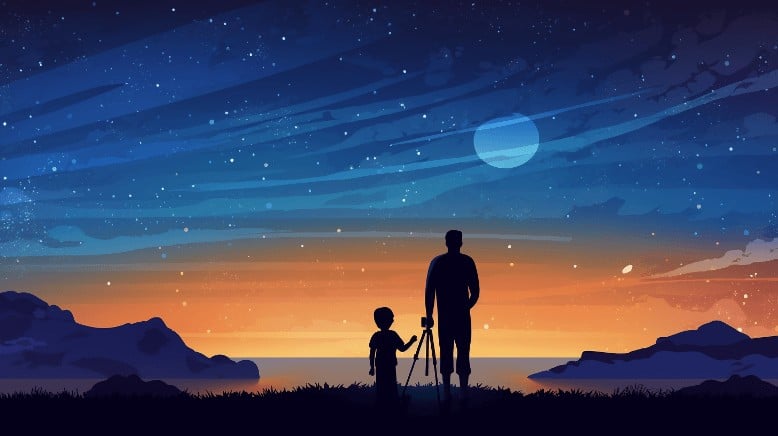
Cost
Your budget will help narrow down your options, but the cheapest telescope worth buying for a child will cost at least $60-70.
As the aperture increases the price tends to go up and the sky’s the limit, but you could get a very good telescope for a few hundred dollars.
Overall
Bringing this all together, you will want:
- An aperture of at least 2.8 inches (70 mm). The higher this number is, the better the capacity of the telescope to provide good views of the night sky.
- The right size and weight for the child who will use it. You’ll need to look at the assembled weight of the telescope and also consider the telescope type (refractor, reflector, or catadioptric).
- An alt-azimuth or dobsonian mount. These are best for astronomy and the easiest to use – steer clear of equatorial mounts for kids. You can also consider a mount with computerized/GOTO functionality.
You then just need to consider your budget for how much you want to spend.
In terms of brand, you may notice that the models recommended above are all from Celestron or Sky-Watcher and that is because they are well-known and reliable makers of telescopes and provide good support (for example, with their YouTube channels).
If you have a search around on Amazon for kids’ telescopes you’ll see a lot of unknown brands. These won’t necessarily be bad telescopes but I don’t think it’s really worth the risk of going for these over something from a known brand.

How to Use a Telescope with Kids
As those with kids know, having the time and space to set up gear like a telescope correctly can be hard, so here are some tips to get it right.
Setup and Calibration
Setting up a telescope may seem complex, but it shouldn’t be. Each model may have a slightly different assembly process, so it’s important to follow the given manual closely or find a good YouTube video to follow.
Many telescopes come with ‘finderscopes’, these are smaller scopes that help you aim your telescope. Align your finderscope during the day by focusing it on a distant object, then adjust your main telescope to focus on the same object.
Additionally, allow your telescope to cool down or warm up to outdoor temperatures for the best viewing experience. Rapid temperature changes can cause condensation on lenses, distorting your view.
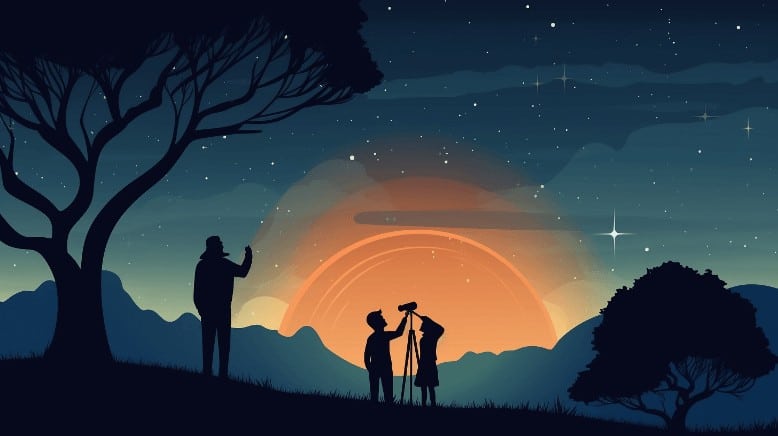
Safe Viewing Practices
Safety should always be paramount when viewing celestial bodies – the most important rule is never to look directly at the sun with a telescope.
The intense light can cause severe and irreversible damage to the eyes.
If you want to observe the sun, use specially designed solar filters that fit onto the end of the telescope.
In addition, if your telescope is mounted on a tripod then make sure that it is stored safely so that a toddler will not pull it down on themselves.
Maintenance and Storage
Proper care and storage of a telescope can significantly extend its lifespan. Some tips are:
- Avoid touching the glass surfaces of your lenses or mirrors, as oils from your skin can damage the optical coatings. Use a lens brush or a can of compressed air to gently remove dust.
- Store your telescope in a cool, dry place, covered and preferably with caps on the lenses to protect them from dust and scratches.
- If your telescope is battery-powered, remember to remove these during storage to avoid leakage.
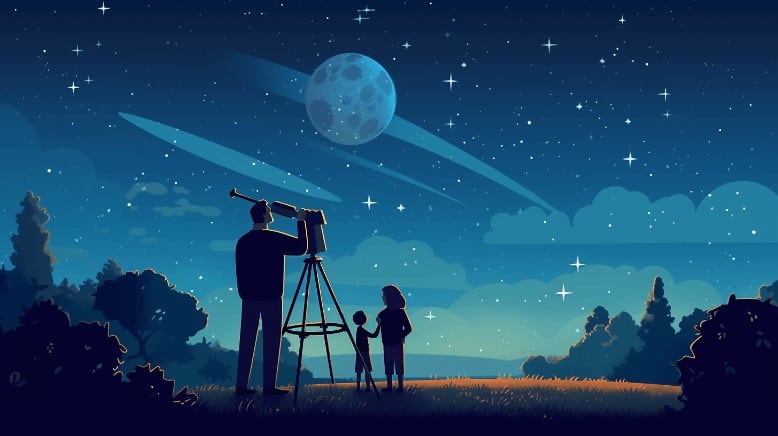
FAQs: Best Telescopes for Children
Which type of telescope is best for kids?
Refractors, tabletop Dobsonian reflectors, and catadioptric telescopes are good for children since they tend to be smaller and lighter.
Large reflectors with equatorial mounts should be avoided as they are heavy, bulky, and harder to use.
At what age can a child use a telescope?
This really depends on the child and only you really know.
Tabletop telescopes could certainly be used by young children, although they’d need help finding things.
If you have bigger telescopes on tripods or computerized models that require power then you have to start thinking about safety issues and also the cost if they get knocked over and broken!
Are smart telescopes good for kids?
Smart telescopes are actually great for families to sit around and use together to find deep-sky objects and take photos of them. They are expensive but newer models are coming down in price.
See the Best Smart Telescopes for more info.
Can children use astronomy binoculars?
Astronomy binoculars are a good option for kids.
High aperture models can give you everything a telescope can and low magnification models can give you a wide field of view that’s perfect for watching things like meteor showers.
See our article on the Best Astronomy Binoculars for more information.
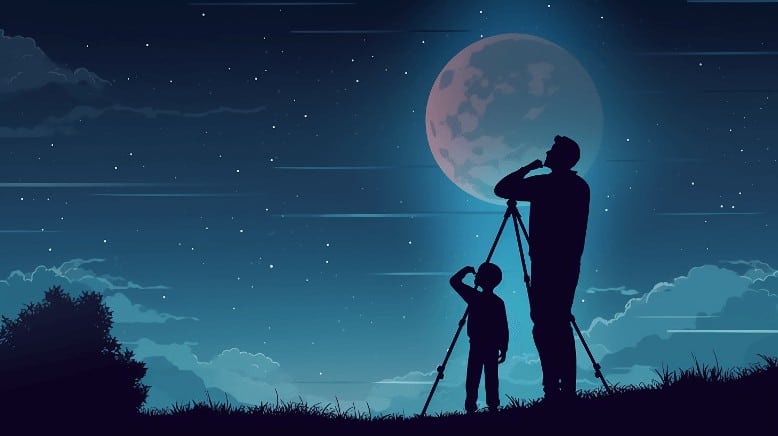
Verdict – What’s the Best Telescope for Kids?
It obviously depends on how old your kids are and what they are like to decide on the best telescope for them.
In summary:
- The Celestron FirstScope is a great budget option that is compact, portable, and easy to use
- The Celestron Travel Scope 70 DX (or Celestron Travel Scope 80) is great if you want a family telescope to take on trips or just if your household would value something that packs away easily into a backpack
- The Sky-Watcher Virtuoso GTI 150P is a good upgrade option if you favor the tabletop telescope type but want more power and also the computerized technology
- The Celestron StarSense Explorer LT 80AZ is really a great deal and gives you many of the advantages of a computerized telescope without many of the downsides and so it’s worth considering for a family to use together with a teenager to use alone.
Please let me know in the comments if have any questions or experience you want to share about using a telescope with your kids.


